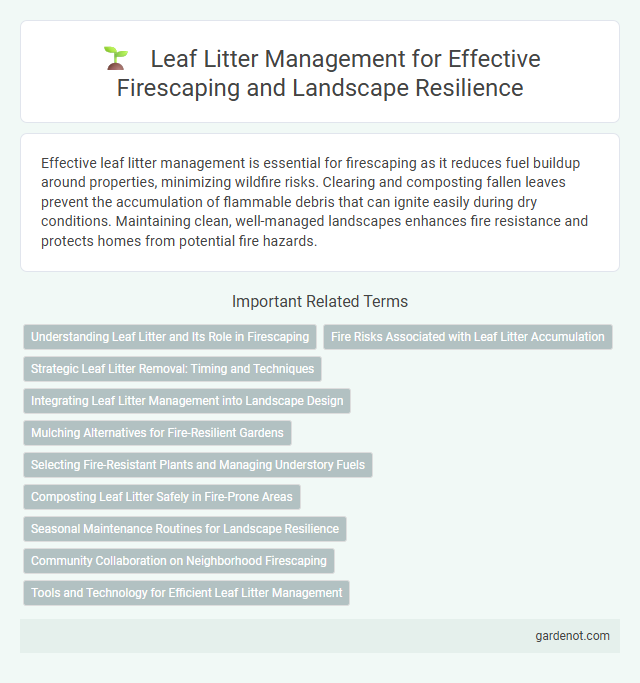Effective leaf litter management is essential for firescaping as it reduces fuel buildup around properties, minimizing wildfire risks. Clearing and composting fallen leaves prevent the accumulation of flammable debris that can ignite easily during dry conditions. Maintaining clean, well-managed landscapes enhances fire resistance and protects homes from potential fire hazards.
Understanding Leaf Litter and Its Role in Firescaping
Leaf litter consists of fallen leaves, twigs, and organic debris that accumulate on the ground, serving as highly flammable material in fire-prone landscapes. Effective leaf litter management reduces fuel loads around properties, minimizing fire risks by preventing the rapid spread of flames during wildfires. Incorporating regular removal and strategic placement of leaf litter is crucial in firescaping to create defensible spaces and protect structures from fire hazards.
Fire Risks Associated with Leaf Litter Accumulation
Leaf litter accumulation significantly increases fire risks by providing highly combustible fuel that can ignite easily and sustain flames. Dry leaves create a continuous layer that facilitates rapid fire spread across the landscape, especially in drought-prone or windy conditions. Effective leaf litter management reduces fire intensity and limits wildfire propagation near homes and vegetation.
Strategic Leaf Litter Removal: Timing and Techniques
Strategic leaf litter removal plays a critical role in firescaping by reducing combustible material that fuels wildfires. Removing leaf litter during dry, low-wind conditions minimizes fire risk while preventing soil erosion and promoting healthy plant growth. Employing techniques such as raking, mulching, and targeted removal around structures optimizes fire defensibility and enhances landscape resilience.
Integrating Leaf Litter Management into Landscape Design
Incorporating leaf litter management into landscape design enhances fire resilience by reducing combustible material near structures. Strategic placement of mulch beds, low-flammability plants, and routine leaf removal create defensible space that mitigates wildfire risk. Utilizing fire-resistant ground covers and maintaining clear zones around buildings optimizes safety while preserving ecosystem benefits.
Mulching Alternatives for Fire-Resilient Gardens
Mulching alternatives such as gravel, decomposed granite, and lava rock reduce leaf litter accumulation, lowering fire risk around homes. These non-organic mulches minimize combustible material, promote soil moisture retention, and create defensible space in fire-prone landscapes. Selecting fire-resistant mulches supports safer, sustainable garden designs tailored for wildfire resilience.
Selecting Fire-Resistant Plants and Managing Understory Fuels
Selecting fire-resistant plants such as manzanita, California lilac, and succulents reduces the likelihood of ignition and slows fire spread, enhancing landscape resilience. Managing understory fuels involves regular removal of leaf litter, dead branches, and dense vegetation to minimize combustible material near structures. Integrating these practices into firescaping creates defensible space that protects properties from wildfire damage.
Composting Leaf Litter Safely in Fire-Prone Areas
Composting leaf litter in fire-prone areas requires careful moisture control to prevent spontaneous combustion and minimize fire risk. Incorporating green materials and regularly turning the pile ensures balanced decomposition and reduces ignition potential. Properly managed leaf compost improves soil health while maintaining defensible space around properties vulnerable to wildfires.
Seasonal Maintenance Routines for Landscape Resilience
Seasonal leaf litter management enhances landscape resilience by reducing wildfire fuel loads and promoting healthy soil conditions. Regular removal during fall and spring prevents accumulation that can obstruct drainage and harbor pests. Integrating mulching and composting leaf litter supports nutrient cycling while maintaining fire-safe zones around structures.
Community Collaboration on Neighborhood Firescaping
Effective leaf litter management plays a crucial role in reducing wildfire risk by eliminating dry, combustible materials from shared spaces. Community collaboration enhances neighborhood firescaping efforts by fostering collective responsibility, coordinating cleanup initiatives, and sharing resources such as mulch shredders and leaf blowers. Joint strategies, including scheduled clearance days and educational workshops, significantly improve overall fire resilience across residential areas.
Tools and Technology for Efficient Leaf Litter Management
Efficient leaf litter management in firescaping relies on advanced tools such as electric leaf blowers, mulchers, and vacuum systems that reduce debris volume and minimize wildfire fuel buildup. Smart technology, including sensor-equipped equipment and robotic leaf collectors, enhances precision and saves time by targeting high-accumulation zones effectively. Integrating these innovations with sustainable practices contributes to maintaining defensible spaces and reducing fire risk in vulnerable landscapes.
Leaf litter management Infographic

 gardenot.com
gardenot.com